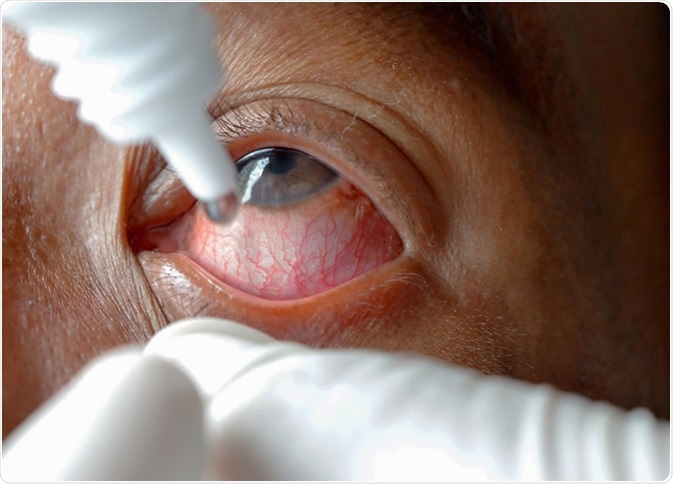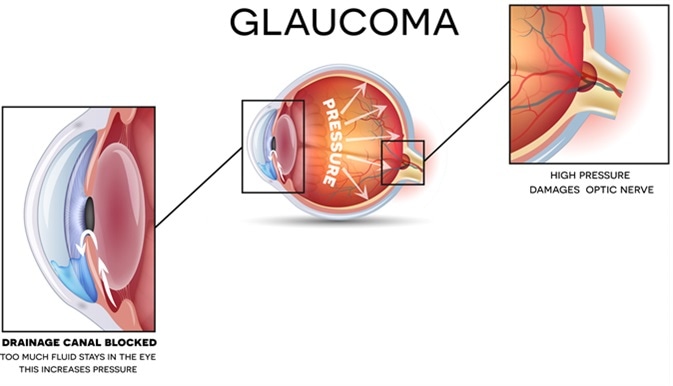Eye drops are most often saline solutions with medications in them to treat various conditions of the eye. Sometimes, they contain no medication and are meant to lubricate the eyes or to rinse out foreign bodies.
Benefits
Lubricating eye drops help replace your eye’s natural moisture when your eyes aren’t making enough on their own. They relieve dryness and irritation, promoting comfort.
In an injured eye, artificial tears also promote surface healing, increase comfort by reducing the feeling of a surface scratch and flush out any residual contaminating or injurious particles. They prevent further damage by keeping the eye lubricated.

Close-up eye while doctor applying eye drop. Image Credit: Anukool Manoton / Shutterstock
Artificial tears have various formulations and viscosities. Some may contain bicarbonate ions, and varying viscosity as well as tonicity. Some do not have preservatives and are to be preferred, being dispensed in sterile single-use containers.
Anti-allergic drops alleviate the burning and stinging of the eyes that is so common with allergies. During allergy season, this can mean the difference between complete misery and moderate comfort. The use of medicated eye drops reduces the chance of systemic side effects from the drugs used when applied correctly.
Glaucoma drops reduce the risk of blindness in this condition by relieving the pressure inside the eye which could otherwise harm the sensitive retina.

Glaucoma and healthy eye detailed structure. Image Credit: Tefi / Shutterstock
Risks
Each type of medication has its own risks as well as benefits, as discussed briefly below.
Steroid and antibiotic eye drops are commonly used to treat infections of the eyes, and to prevent bacterial infection following ocular surgery. They must be continued for as long as prescribed as otherwise the infection may come back.
Glaucoma drops are meant to reduce the fluid inside the eye and promote its drainage. Some common types include prostaglandins, alpha blockers, and carbonic anhydrase inhibitors. They must be used as prescribed to protect vision.
Anti-allergic eye drops frequently contain antihistaminics or non-steroidal anti-inflammatory drugs (NSAIDs) to suppress the release of inflammatory substances from mast cells in the eye. They also dilute the allergen.
Mydriatic eye drops are also known as dilating drops and are used to allow eye specialists to view the inside of the eye through the pupil. Afterwards the patient may suffer from light intolerance, fuzzy vision, and eye watering for a short period until the effects of the drug wear off. Driving should be avoided by asking a friend or relative for a ride before and after such an examination.
Redness-relieving drops contain decongestants, which are ingredients that constrict the blood vessels in the conjunctiva and so make the eye appear whiter. However, on continued use for a long time, the eye blood vessels actually become more dilated than ever, which is called the rebound hyperemia effect. They should be used for only a couple of days, at most.
Redness-relieving drops may also prevent a more serious problem from being recognized and treated, leading to worsening of vision. They can also cause the eye to feel dry due to reduced tear secretion.
Eye irritation and pupil widening are other side effects of overuse. In addition, the eye may also stop responding to them after some time.
General Risks
Preservatives and thickening agents in eye drops can cause irritation of the eye if used for too long. This is another reason why no eye drop should be used beyond the prescribed period unless it is a simple saline solution. Not more than four doses of any eye drops containing preservatives should be used in one day. For more frequent dosing, eye drops without preservatives must be selected.
While applying eye drops, the container should not touch the eye or any surface to avoid contaminating the tip and spreading the infection. Bottles should not be shared. The lid must also be tightly and carefully closed as soon as application is over. Bottles with loose rings or seals should not be used as the seal may fall into the eye during application.
Even artificial tears may cause side effects such as transient clouding of vision immediately after application. Driving or operation of machinery must be avoided until vision is clear again.
Any of the ingredients in the eye drops could cause allergy or anaphylaxis. The product should not be used and medical help should be obtained.
If over-the-counter eye drops are required every few days or every day, it is wise to see an eye doctor rather than continue self-treatment.
Finally, no eye drop solution should be used for more than four months after opening it as fungal or bacterial contamination is very likely. Single-use containers must be disposed of safely after a single use.
Further Reading
Last Updated: Jul 18, 2023